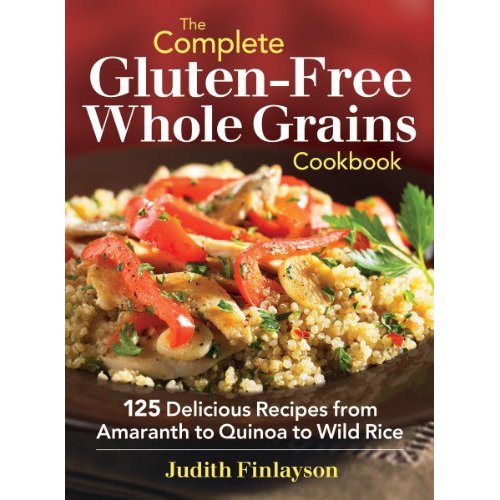Most of ya’ll know that an ongoing frustration for me is the fact that it’s generally only possible to find gluten-free or whole foods — rather than both at once. (The Paleo trend is helping a bit with that. But I digress.) So switching to a gluten-free diet can often mean a step backward in terms of nutrition. Author Judith Finlayson has taken steps to change that with her new cookbook, The Complete Gluten-Free Whole Grains Cookbook, which Robert Rose (the publisher) sent me to review.
The Complete Gluten-Free Whole Grains Cookbook contains 125 recipes in ten different categories: breads & breakfasts, appetizers, soups, salads, poultry, fish & seafood, meat, meatless mains, sides & sundries (and basics), and desserts. Before you get there, though, there’s an informational section.
Very briefly, “what is gluten and why does it matter?” is addressed. It’s important to note that most of the additives the author specifies as sometimes containing wheat generally do not contain wheat in the U.S. (There is a lot of labeling stupidity where U.S. foods are concerned, but this is one area the labeling is actually helpful. Things like modified food starch don’t contain wheat unless they specify “from wheat.”) The book is published in Canada, so this information is still useful for many readers — just didn’t want my American readers to panic unnecessarily!
Then there are a couple of pages about whole grains in general: why we should eat them, what makes them different, etc. A list of some gluten-free grains is provided. A list of non-grain ingredients frequently used in gluten-free baking is also found here, with a brief description of each one and what it’s used for.
Then we get to the grains. This is my favorite part of the book! Nineteen pages are devoted to describing each of the grains used in the book. Amaranth, Buckwheat, Corn, Job’s Tears, Millet, Oats, Quinoa, Rice, Sorghum, and Wild Rice are all thoroughly addressed. (Some of these aren’t true grains. Rather, they’re known as “pseudo-grains,” because they’re not botanically grains, but they’re used as grains. Kind of like tomatoes and the whole fruit/vegetable debate.)
First, the grain is described. Then you’ll find a highlighted list of whole-grain forms of the food. Its “culinary profile” is provided — that is, how it’s used in cooking. A brief paragraph tells you what’s especially good about it, nutritionally. A “nutrition profile” is shown. (This looks like the nutrition panel on purchased food.) Instructions are given for buying/storing it, and for cooking it. In many instances, several different cooking methods are described. And a photograph of every grain is used to illustrate its section, so you know exactly what it looks like.
To be honest, I wasn’t as big a fan of the recipes, overall. There are a few that look tasty, but a lot of them are what our kids would likely consider “weird” or people would call “health food” (as opposed to healthified “normal” food). Someone with a more sophisticated palate might really appreciate them, but I don’t see them getting much use around here. I will use the book, anyway, if only for the grain-by-grain information at the beginning.
The book is printed in full color. I would say that about one out of every five recipes is illustrated (with a photograph). It is well-indexed. Nutrition information is provided for the recipes, but it’s in the back of the book, not listed with the individual recipes.
Do you think this would be useful for your family? Do you have other gluten-free whole-grain cookbooks or recipes?
Disclosure: I was provided by the publisher with a copy of this book to facilitate my review. As always, all opinions expressed here are entirely my own.

Leave a Reply